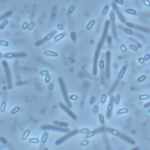Lien vers Pubmed [PMID] – 1849604
Mol. Microbiol. 1991 Jan;5(1):137-48
We have previously reported the identification of two genes, pilA and pilB, which act in trans to regulate pilus expression in Neisseria gonorrhoeae. Here we show that PilA and PilB have amino acid sequence similarities with members of the two component ‘sensor-regulator’ family of proteins. PilB has homology with histidine kinase sensors. Alkaline phosphatase fusions to the predicted sensor and transmitter domains are described. Their PhoA activity and cellular location suggest that PilB is inserted in the cytoplasmic membrane and predict periplasmic and cytoplasmic locations for the sensor and the transmitter domains, respectively. PilA has homology with response regulators in its N-terminal part, and with components of the eukaryotic protein secretory apparatus (SRP 54 and SRP receptor) as well as two Escherichia coli gene products in its C-terminal part. In particular, it contains a putative GTP-binding site. Mini-transposon insertions into different regions of pilA were obtained. The phenotypes and genotypes of these mutants and preliminary biochemical studies of the gene products of two of these mutants lend further support to the hypothesis that PilA is a DNA-binding response regulator and confirm that it participates in an essential function in the bacterium.

